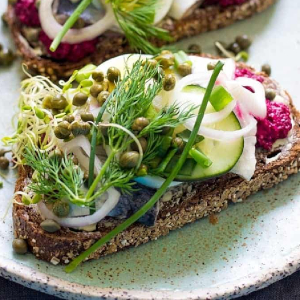Folks often react with surprise when they learn that Denmark – the tiny European nation bracketed by the North and Baltic Seas – is also the ‘landlord’ of Greenland. But that’s far from the only surprising fact about the country that, among other distinctions, is also the historic home of the Vikings!
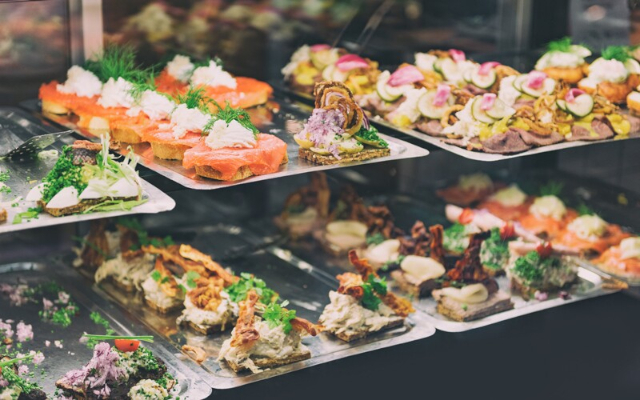 Smørrebørd: The famous open-faced sandwich of Denmark!
Smørrebørd: The famous open-faced sandwich of Denmark!
“Something is rotten in the State of Denmark,” supporting character Marcellus observes to first-stringer Horatio as they debate whether to follow Hamlet and his father’s ghost out into the night, in Act One, Scene IV of the great Shakespearean drama. I’m pleased to report that the comment was entirely political, and technically metaphorical. One look at Denmark’s national cookbook confirms that the place boasts a colourful and varied culinary culture with contributions from many influencers.
Bordered on land by Germany on the south and Sweden on the north, Denmark is bracketed on the west by the North Sea and the East by the Baltic. It’s an unusual sovereign state, geographically, consisting of a peninsula and several large islands, the largest of which is home to the capital, Copenhagen.
A blend of Scandinavia and Europe
The official Danish national website sums up the country’s cuisine thus:
“Traditional Danish food is based on what was historically available nearby or could be farmed during Denmark’s short summers. Cabbage and root vegetables like beets were an important part of the diet, along with rye bread, fish, and pork.
“Open-faced sandwiches, known as smørrebrød, are among the best-known examples of traditional Danish cuisine. These small half-pieces of rye bread are topped with fried fish, pickled fish, eggs, potatoes, or cold meat, and sometimes horseradish and onion. They are eaten at lunchtime, either as part of a packed lunch or in a company cantine.”
“Larger traditional meals are often based on fish or pork, sometimes ground and fried as meatballs. The “national dish of Denmark” is stegt flæsk – pieces of pork, fried until crisp, and then served with boiled potatoes and parsley sauce.”
“Ironically, the tasty frosted pastries known to much of the world as ‘Danish’ are not Danish at all. They originated in Austria, and are known to the Danes themselves as ‘Viennese bread’.”
On our menu today
Smørrebrød: Not ‘Smorgasbord’, which is a Swedish tradition, involving a buffet of traditional dishes, but a style of open-faced sandwich which starts with buttered Rye Bread and may be topped with any combination of meats, cheeses and garnishes you might fancy. One of the most colourful and visually appealing Danish foods!
Stegt Flæsk: Simply, crispy Pork Belly. Looks a lot like the strip-style bacon we love in the West – because that’s what it is, cut Texas-thick!
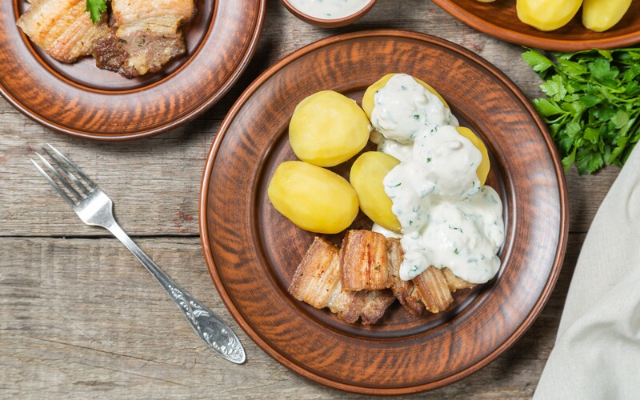
Stegt Flæsk med Persillesovs, a plate with Bacon, Boiled Potatoes and a traditional Parsley Sauce, is considered Denmark’s national dish.
Flæskesteg: A traditional Nordic Pork Roast; a favourite at Christmas. The secret to a perfect Flæskesteg is to leave the skin on the top of the loin roast and bake until it’s golden and crispy. You cut grooves into the skin and salt generously to ensure that the cracklings turn out crispy and full of flavour.
Frikandeller: ‘Danish Meat Balls’. But more like chubby little slider patties. Made simply, from pork and veal, onions, salt and pepper. Fry the patties in margarine or butter for about 15 minutes per side, until cooked through.
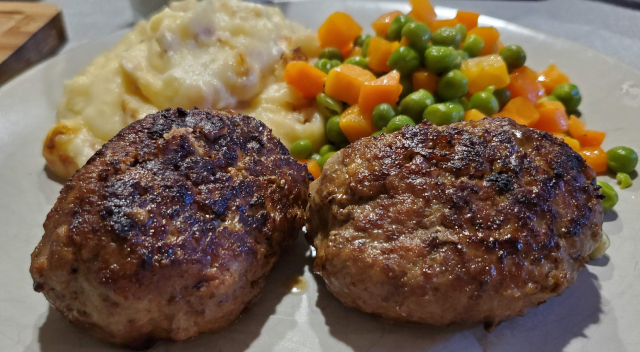
Recipe contributor Marigat suggests, “Serve warm with a brown sauce, small red boiled potatoes, and sweet and sour cabbage.”
Karbonader (Krebinetter): Breaded Pork Patties. Bigger than Frikandeller and breaded; recipe contributor Kim Nielsen recommends you put them through the standard breading ritual twice to build up a major coating. Sister Erin clued me in to this additional tip: refrigerate the patty between breading layers to ensure the second layer sticks seamlessly to the first! The traditional accompaniment is a ‘stew’ of carrots and green peas, but modern cooks often substitute a green salad and a big platter of buttered bread.
Forloren Hare: Mock Rabbit; Danish Style Meatloaf. A very simple dish, made with equal parts of ground pork and ground veal or beef. (Are you starting to get a feel for Danish tastes in red meats?)
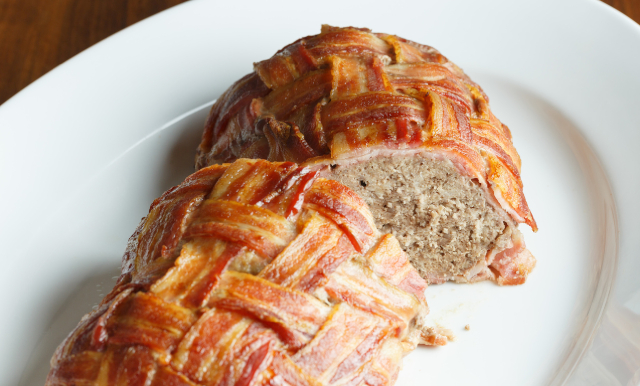
Unlike most meatloaves, it’s wrapped in bacon strips before baking. Forloren Hare is traditionally served with a brown sauce made from pan drippings, red currant jelly, and whipping cream!
Fish & Seafood: All kinds; Denmark is surrounded on almost all sides by water! Smoked and Pickled salt water species are particularly favoured. This is perhaps the strongest Scandinavian impact on the Danish diet. Fish Balls, Fried Fish Fillet Smørrebrød with a remoulade (see photo, top of page), Pan Fried Fish (or seafood, or salmon) Patties, Creamed pickled white fish, and Herring in all imaginable prsentations! Just Google ‘Danish Fish Dishes‘ and prepare to be washed away in a tidal wave of great recipes!
Pølser: A Danish Hot Dog. The Danish version is far removed from the American Style Coney Island Dog made famous by Nathan Handwerker in 1916, and promoted around the world ever since. It’s a long sausage that sticks out from, both ends of the conventional looking bun, with a snap to its skin that Danes insist on.
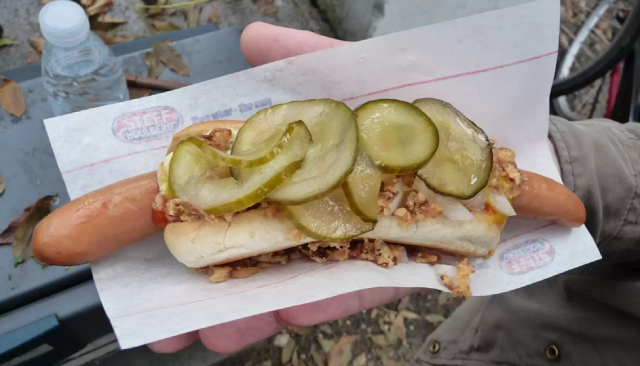
And it’s dressed much classier and ‘gourmet’ than the every-day hot dog we’re used to: Ketchup mixed with apple sauce, spicy mustard, remoulade, diced onions, sweet pickles, and crispy fried onions. Pølser is the national street food of Denmark. In Copenhagen, it’s said they have at least one pølsevogn, or hot dog cart, in every street!
Kartofler: Caramelized Potatoes. A favourite festive side, once enjoyed only by the rich; sugar and butter were expensive! Just boil the spuds as usual, then caramelize in a pan with butter and sugar melted together, rolling them slowly and gently so the potatoes don’t break. You want a smooth, glossy surface!
Scandinavian + European = Denmark!
As I said in the preamble to this post, Denmark may seem small and insignificant in the geographic shadow of its much-larger neighbours. But it’s huge in culture, with roots tracing back to the Vikings, and influences from a multitude of cuisines. Tomorrow, we’ll embrace Danish Breads and baked goods. Again, a fusion of eastern, western and northern European traditions!
~ Maggie J.

